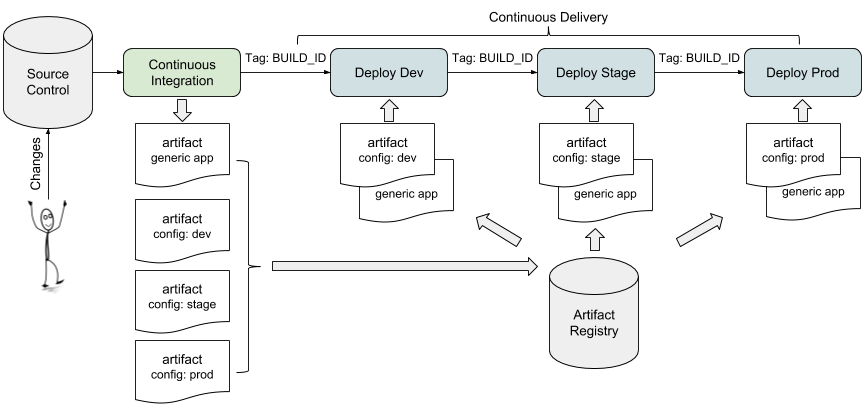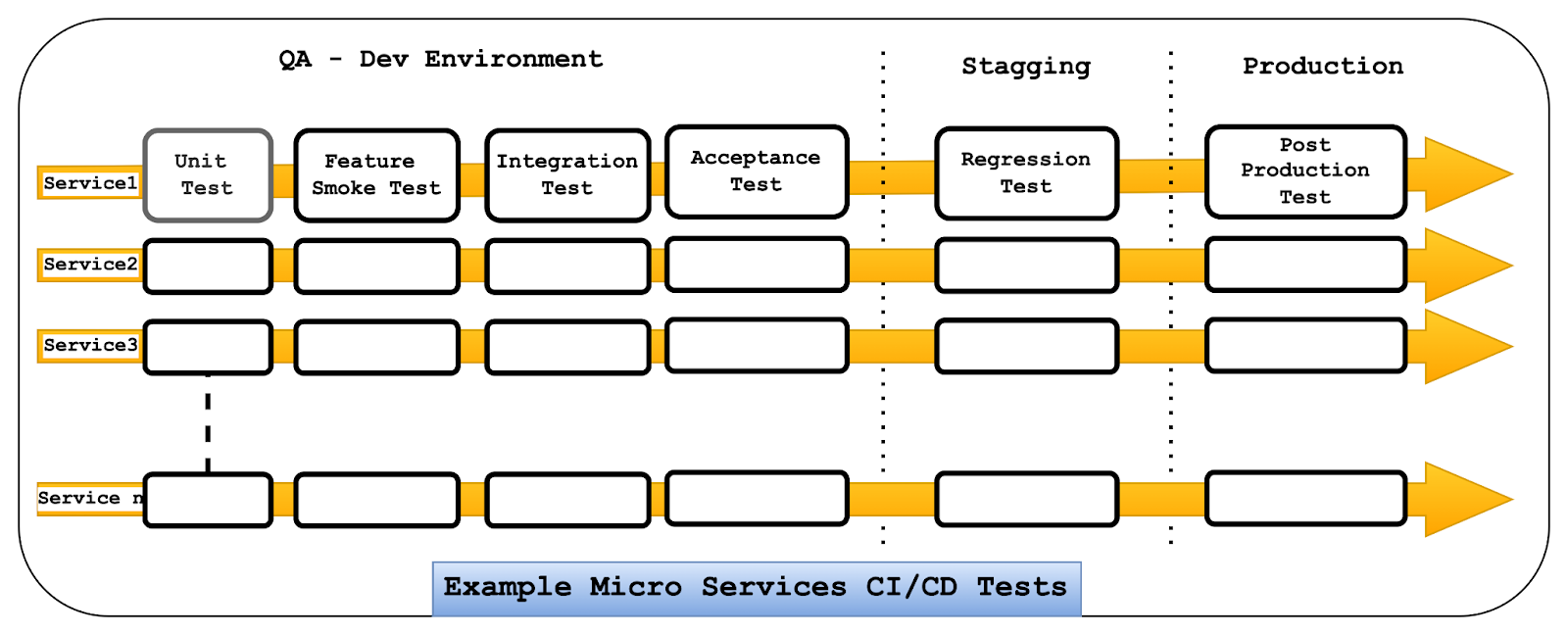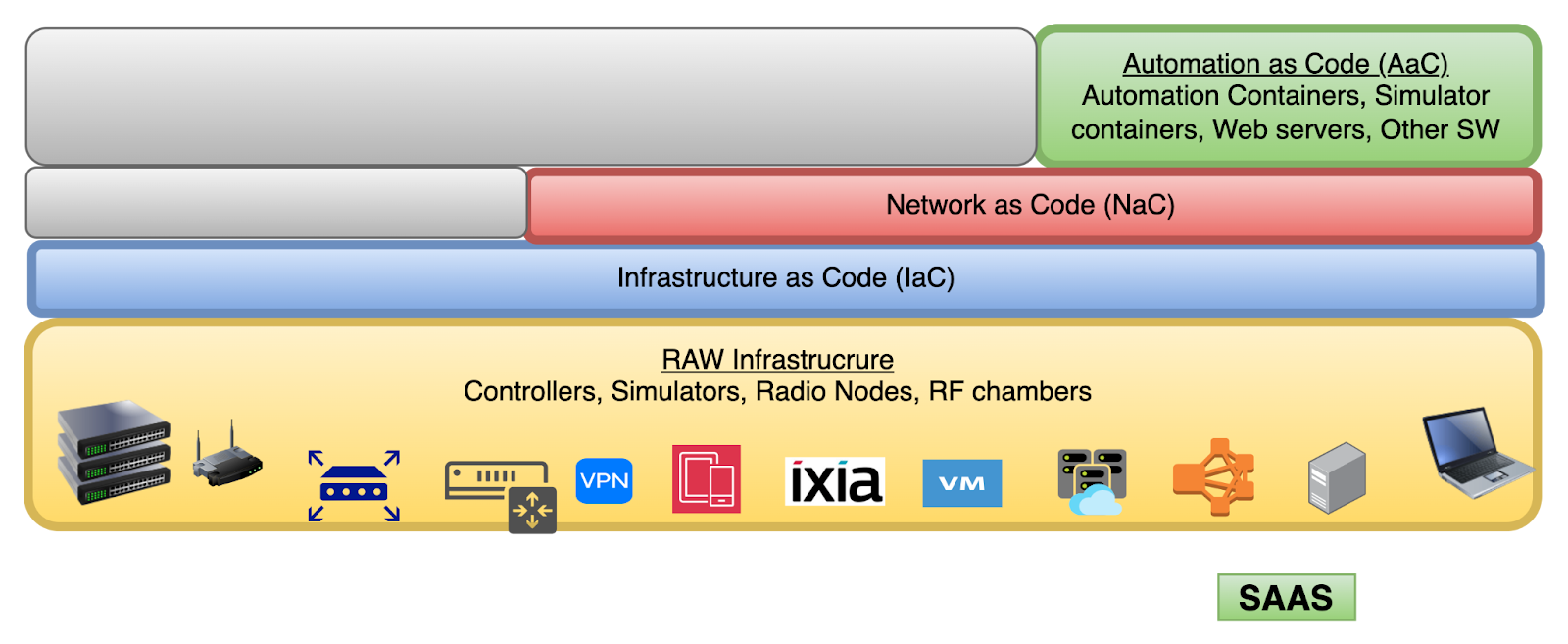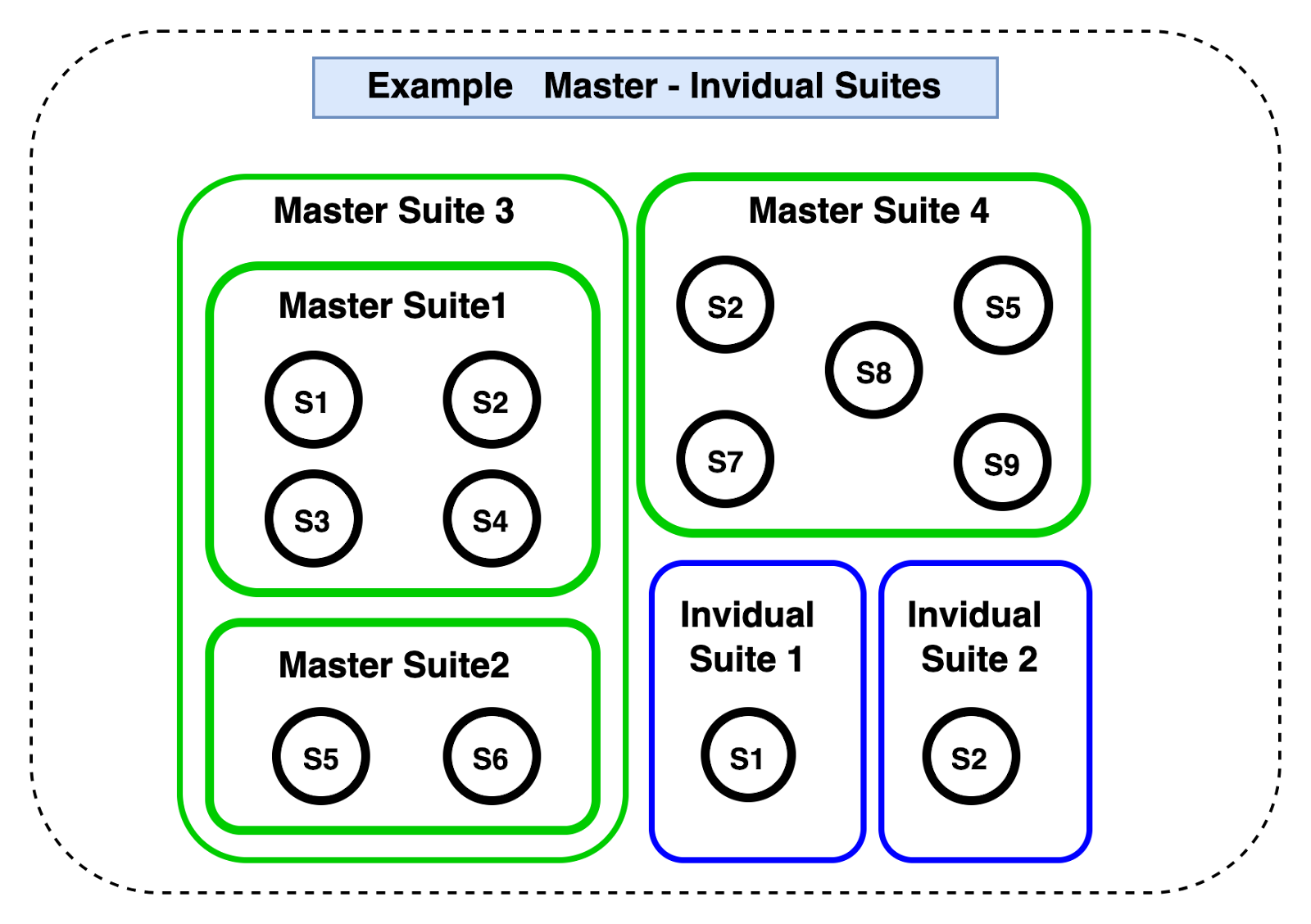Abstract: The adoption of microservices architecture has revolutionized software development by enabling scalability and modularity. However, the parallel testing of microservices presents unique challenges, especially for networking products, where testing complexity and resource costs often impede efficiency. This article explores strategies to optimize parallel testing, including resource-sharing, intelligent test orchestration, and adaptive frameworks, to maintain high-quality testing standards without inflating budgets or delaying tag promotions in CI/CD workflows.
CI/CD process of the monolithic application
A simplistic view of the CI/CD process of the monolithic application as shown in the diagram below involves running smoke tests in development or QA environments before moving the tag to staging, running regression tests, and then promoting the tag to production.
Reference from: https://nodramadevops.com/2019/02/improving-software-delivery-performance-with-continuous-integration-and-continuous-delivery/
CI/CD Process in Microservices application
However, there are often additional intermediate phases in the CI/CD pipeline, determined by the application's complexity, criticality, and organizational policies. Each phase is designed to execute specific test suites that validate the application's readiness for subsequent stages.
Unlike monolithic applications where testing follows a linear progression, microservices often require concurrent validations across multiple services.
Here is an example of a continuous deployment process that demonstrates how these phases are organized within a microservices architecture.
A high-level view of microservices is well-articulated in the following article: https://www.spiceworks.com/tech/devops/articles/what-are-microservices/ It provides an insightful overview of microservices architecture, advantages, examples, and best practices.
Limitations of Simplistic Approaches in Microservices CI/CD
While there are straightforward solutions to address testing challenges in microservices CI/CD pipelines, these approaches often prove infeasible due to their limitations in scalability, cost, and efficiency. Below are two such methods and their inherent drawbacks:
Replication of Smoke/Regression Setups:
One simple strategy involves replicating smoke or regression testing setups for every microservice at each stage of the pipeline. This ensures thorough validation of all services independently. However, the approach is impractical because:
- Exponential Cost Increase: Setting up and maintaining multiple identical environments leads to infrastructure expenses multiplying several times, often exceeding budget constraints.
- Operational Complexity: Managing numerous replicated setups adds significant overhead in terms of coordination and maintenance efforts.
Compromising Tag Promotion Frequency:
Another option is to group microservices into a fixed number of setups and trigger these setups whenever a microservice changes. While this reduces the number of setups:
- Group Dependency Bottlenecks: A single test failure in one microservice can halt the tag promotion for all grouped services, even if other services remain unaffected.
- Deployment Delays: Over time, these bottlenecks lead to delayed deployments, reducing the agility and responsiveness of the CI/CD pipeline.
Innovative Strategies for Optimizing Microservices Testing
While the earlier simple approaches may seem logical initially, they fall short in meeting the requirements for scalable, cost-effective, and efficient parallel testing in microservices architecture. Addressing these challenges requires adopting innovative strategies. The following three approaches collectively aim to optimize resource utilization, reduce redundancy, and enhance testing efficiency:
- Cloud Resource Sharing for Efficient Testing
- Intelligent Test Orchestration: Master vs. Individual Suites
- Hierarchical Service Levels for Redundancy Reduction
1. Cloud Resource Sharing for Efficient Testing
Cloud-based lab environments have become a crucial solution for optimizing resource utilization during parallel testing. These environments provide Infrastructure-as-a-Service (IaaS), Platform-as-a-Service (PaaS), and Software-as-a-Service (SaaS) capabilities that dynamically adjust to evolving testing requirements.
For a more in-depth exploration, refer to the detailed article on CloudLAB available at https://techbullion.com/leveraging-cloudlab-solutions-for-scalable-networking-product-testing
These environments offer several significant advantages:
- Shared Equipment, Cost Savings, and Reduced Maintenance: SaaS-based services in CloudLAB enable the use of shared testbeds across all phases and types of test suites. By dynamically allocating setups only as needed, CloudLAB minimizes costs and reduces the effort required to maintain physical testbeds.
- Improved Collaboration and Elimination of Duplicate Efforts: CloudLAB promotes collaboration by allowing QA, development, and automation teams to share setup environment tags. This functionality addresses a key challenge in issue reproduction, enabling teams to replicate specific conditions across multiple phases without the need to recreate environments.
- Enhanced Parallel Testbed Availability: Rapid setup and teardown capabilities in CloudLAB allow teams to execute more parallel smoke and regression tests, accelerating validation processes and improving workflow efficiency.
- Centralized Data and Metrics for Continuous Improvement: CloudLAB consolidates resource usage data in a centralized cloud-based system. This enables teams to identify bottlenecks and leverage data-driven insights to optimize testing efficiency.
2. Intelligent Test Orchestration: Master vs. Individual test suites
Efficient test orchestration leverages the natural dependencies between services, reducing redundant test runs. For example, testing one service often inherently validates its dependent services. Similarly, executing a single, comprehensive end-to-end scenario can cover multiple interconnected services, eliminating the need to run several simpler, isolated tests.
- Master Smoke Suites: These validate multiple services. For example, if updates affect both the data processing and reporting services of a networking product, a master suite can test their end-to-end functionality in one execution.
- Individual Smoke Suites: These are tailored to validate changes in specific services. For example, if the authentication service is modified to enhance user token validation, only its specific individual smoke test is triggered, focusing solely on its functionality and dependencies.
The orchestration logic intelligently selects the most efficient combination of test suites by leveraging a JSON file that contains key information, including:
- Microservices Coverage: The list of services tested by each suite.
- Testbed Requirements: Specific setups needed for execution.
- Approximate Execution Times: Predicted durations for both master and individual test suites.
It dynamically evaluates multiple factors to optimize test selection, such as:
- Change List: Identifies microservices impacted by recent updates.
- Execution Time Constraints: Ensures adherence to pipeline time limits.
- Device Availability: Allocates resources efficiently based on availability.
- Resource Optimization: Balances workloads across available test environments.
This intelligent orchestration accelerates feedback, reduces redundant runs, and streamlines the CI/CD pipeline. Future enhancements, such as dynamically creating master smoke suites using tagging mechanisms in test scripts and setups, could further refine this process. However, such advancements are beyond the scope of this article.
3. Hierarchical Service Levels for Redundancy Reduction in Parallel Testing
Redundancy in parallel testing often occurs when dependent services are unnecessarily tested after foundational services fail. A hierarchical approach, where services are categorized into levels, can significantly reduce such inefficiencies.
The dependency JSON file provides a comprehensive overview of the interdependencies of services, enabling the test orchestration logic to organize services into levels for a logical and efficient progression of testing.
Service Levels:
- Level 1: Foundational Services: Core services such as databases or authentication systems. These services are tested first, and downstream testing halts if they fail, preventing redundant executions. Test orchestration prioritizes these services for resource allocation.
- Level 2: Intermediate Services: Services that depend on Level 1 but also act as dependencies for higher levels. These are tested only if the foundational services pass.
- Level 3: Peripheral Services: Edge services, such as monitoring or analytics. These are validated last to ensure that all upstream dependencies are stable before testing begins.
Example Use Case:
If the database service (Level 1) fails, subsequent testing of the routing service (Level 2) and log aggregation service (Level 3) is skipped until the database issue is resolved. However, if over 50% of resources are idle and a Level 2 test suite requires minimal execution time, the test orchestration logic may preemptively trigger its tests to mitigate overall delays.
This adaptive, hierarchical approach, driven by the dependency JSON file, ensures efficient resource utilization and minimizes redundant runs caused by foundational failures. It strikes a balance between logical progression and resource availability, optimizing the overall testing workflow.
Conclusion
Parallel testing is a fundamental component of DevOps for microservices, yet inefficiencies in resource utilization and redundant workflows can significantly diminish its effectiveness. By adopting cloud-based solutions for resource sharing, implementing intelligent test orchestration, and employing hierarchical frameworks, organizations can enhance parallel testing efficiency without escalating costs or delaying tag promotions. These strategies facilitate faster and more reliable delivery of networking products in a microservices-driven environment, laying the foundation for scalable and agile DevOps processes. As microservices increasingly dominate modern architectures, such innovations will be essential to sustaining efficient and scalable DevOps workflows.
References:
- Stephen Kuenzli (2019). Improving Software Delivery Performance with Continuous Integration and Continuous Delivery. Retrieved from https://nodramadevops.com/2019/02/improving-software-delivery-performance-with-continuous-integration-and-continuous-delivery/
- Hossein Ashtari (2022). What Are Microservices?. Retrieved from https://www.spiceworks.com/tech/devops/articles/what-are-microservices/
- Kumarswamy Dontamsetti. (2022). Leveraging CloudLAB Solutions for Scalable Networking Product Testing. Retrieved from https://techbullion.com/leveraging-cloudlab-solutions-for-scalable-networking-product-testing




